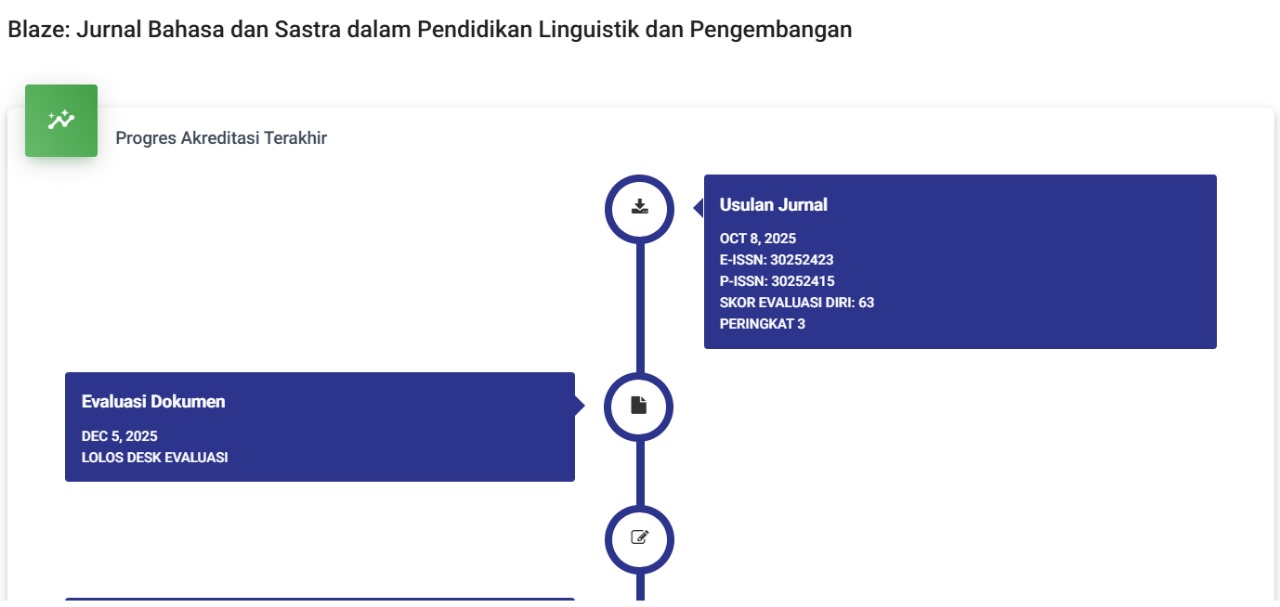Prosody Analysis of Acoustic Language Phonetic Research on Minang Kabau
DOI:
https://doi.org/10.59841/blaze.v1i4.650Keywords:
Prosody Analysis, Minang Kabau Language, instrument praat, vowel systemAbstract
Prosody in the Minang Kabau language in this study was studied with 5 words, to find formants, frequency, intensity. They are /saruang/, /urang, /goreang/, /putiah/, /karajo/. The results show that the dominance of the predominant vowel is very high in these words. The words were also studied with frequency, intonation and duration to find the sound contour statistically. The results of the study are displayed through diagrams tables and explanations to understand the characteristics of sound, improve language learning ability. The earlier formant diagram shows the position of the tongue, with F3 representing the rear position, F2 representing the middle, and F1 representing the peak of the vowel (Predominant). The research method is the use of the Praat instrument to discuss the recorded and analyzed sounds. Minang Kabau, also known as Minang, has some phonetic peculiarities that distinguish it from other languages. Its broad vowel system, which comprises seven or eight vowels depending on dialectal variety, is one unique feature. Among these vowels are five monophthongs (/i, e, a, o, u/) and two or three diphthongs (/ai, au/, and maybe /oi/). Apart from this, there are vowel length distinctions in Minang Kabau, with both long and short vowels conceivable. In addition, the language has a consonant phoneme inventory that includes voiceless stops (/p, t, k/) and voiced stops (/b, d, g/), as well as a variety of other consonants.
References
Asman, A. (2020). A Praat Analysis of Vowel System in Minangkabau Language. Lingua Cultura, 14(2), 150-159.
Beckman, M. E., & Venditti, J. J. (2015). The phonetics and phonology of the rising and falling tones in English declarative intonation. Journal of Phonetics, 53, 49-69.
Bruggen, Sharon Van, et al. (2016). Assessing changes with loudness measures in speech therapy. Journal of Speech, Language, and Hearing Research, 59(5), 1186-1196.
Crystal, D. (2014). The Cambridge encyclopedia of language. Cambridge University Press.
Cutler, A., & Bunnell, H. (2019). Phonetic perspectives on speech segmentation. Language, Cognition and Neuroscience, 34(3), 291-301.
Dauer, R. M. (1983). Stress-timing and syllable-timing reanalyzed. Journal of Phonetics, 11(1), 51-62.
De Jong, K. (2011). The acoustics and perception of intonation. In T. S. Kühnlein, A. D. Friederici, & A. W. Sollaci (Eds.), Basic Issues in Psycholinguistics (pp. 175-204). Springer.
Dziubalska-Kólak, A., & Klessa, K. (2013). Nasalized realizations of /ɛ/ and /a/ in four Polish dialects: Acoustic properties and perceptual cues. Linguistics Vanguard, 1(1), 183-194.
Farnetani, E., & Pietro, G. (2012). Handbook of phonetics. Oxford University Press.
Gussenhoven, C., & Chen, A. (2018). Prosody in linguistics. Glossa: a journal of general linguistics, 3(1), 49.
Hasni, S. (2018). A Praat Analysis of Prosody in Minangkabau Language. Jurnal Ilmu Budaya, 6(2), 199-214.
Hawthorne, K., & Fischer, S. (2020). Speech-language pathologists and prosody: Clinical practices and barriers. Journal of Communication Disorders, 87(May), 106024
Hayward, K. (2013). Experimental Phonetics. New York: Routledge
Hazan, V., & Simpson, A. P. (2015). The Soundscape of English. In M. Dziubalska-Kołaczyk & D. Przedlacka (Eds.), English Pronunciation Models: A Changing Scene (pp. 83-96). Cambridge University Press.
Ladd, D. R. (2008). Intonational phonology. Cambridge University Press.
Ladefoged, P., & Johnson, K. (2014). A course in phonetics. Cengage Learning.
Ladefoged, P., & Johnson, K. (2015). A Course in Phonetics (7th ed.). Cengage Learning.
Liu, F., & Xu, Y. (2017). Perception of Thai tones by Mandarin and Min-speaking listeners: Evidence from F_0 contours analyzed by Praat. Journal of Phonetics, 64, 96-109.
Lu, L. (2012). Acoustic Correlates of Tonal Production and Perception in Mandarin Chinese. In Intonation: Analysis, Modelling and Technology (pp. 3-20). Springer.
Niebuhr, O., Verhoeven, L., & Gillis, S. (2013). The melody in Dutch non-native speech. An acoustic analysis of non-native Dutch and other Germanic accents. Phonology, 30(3), 453-483.
Sluijter, A. M., & van Heuven, V. J. (2012). Allophony. In R. Adler, M. K. Brown, & M. Byram (Eds.), The Cambridge Handbook of Phonology (pp. 225-247). Cambridge University Press.
Ten Bosch, L., Stankiewicz, Z., & Boves, L. (2015). Durational correlates of stress perception: Application of a new technique to spontaneous data. Frontiers in Psychology, 6, 747.
Yanti, F. (2019). Diphtong Analyses of Minangkabau Speech: A Praat Analysis. Indonesian Journal of Applied Linguistics, 9(1), 28-42.








